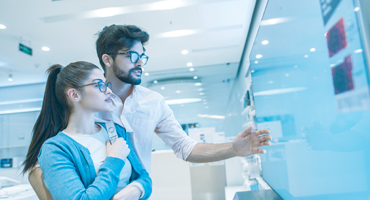Tech rescue: Smart retail cost-savers
July 4, 2019
Technological innovations are helping retailers provide remarkable experiences for their customers, engendering loyalty and a sense of excitement
BY ANDREW HIND
TRADITIONALLY, retail has been relatively slow in embracing technology. But no longer. The pace at which technology, particularly smart technology, is being adopted by retailers is almost fre¬netic. As a result, the industry is evolving faster than ever before.
“We’ve had technology for a long time, but we’ve just recently learned how to leverage it and in fact are still learning,” explains Madan Murthy, General Manager of Canadian Retail Solutions. “The digital and physical aspects of retail are being merged together to be mutually supportive. Technology is dramatically changing the way retail operates.”
In this article, we identify five smart technological innovations that have retailers excited because they offer the promise of streamlined operations and the elimination of unnecessary costs, freeing associates for an increased focus on the consumer.
Machine Learning
One key to success moving forward will be a retailer’s ability to leverage precious consumer data with smart technology to make sense of shopper habits. Because a customer’s shopping journey—from browsing to, hopefully, purchasing—now covers a range of real-world and digital channels, from bricks-and-mortar to social media, apps, and websites, it can be difficult to track individuals and their specific needs and interests. The good news is that advances in machine learning (ML) have made it possible to address these issues via large scale data collection and analysis, providing real-time insight into shopper behaviour.
While machine learning has a host of valuable appli¬cations, Murthy believes the most critical way it can be applied is inventory management. Inventory represents a store’s number one asset and cash investment, so it makes sense that managing inventory be a priority.
“Inventory planning helps drive cash flow, which is a huge thing in retail. It tells you when to buy, what to buy, and how much to buy. Inventory planning isn’t a guessing game anymore. ML can be leveraged to look at past trends to predict the future. It analyzes sales performance to determine market trends and identify strong- and weak-performing products to enable you to buy smarter,” he explains.
Most retailers know how much they’re selling, but monthly or weekly sales updates don’t cut it any longer. In the omnichannel age, actual inventory levels become very important, especially if you want to promise in-store inventory to online shoppers. Having a better understanding of your real-time inventory levels increases sales, achieves higher levels of customer satisfaction, and in-creases associate efficiency by eliminating the need to check whether an item is actually in-stock.
“Inventory planning is key in retail, especially considering the tight margins” asserts Murthy. “Inventory control helps prevent markdowns. I hate markdowns—they should never happen. Having too much means you bought too much, which means you spent too much.”
Robots
We tend to think of robotics as something belonging to some science-fiction future, but in truth they are already among us, including in the retail sphere. They come in a variety of forms to perform specialized roles and will be increasingly important to retail success in the next few years. Just don’t expect some Star Wars-like droid.
Walmart, for example, has invested in a self-driving shopping cart. The shopping cart, connected to a mobile app, follows the customer around the store, and is smart enough to avoid obstacles like other carts and shoppers. Now customers will have both hands free to select items off the shelf, research products or review flyers on their mobile devices, or even just cling onto a wandering child.
Best Buy has a different take on the employment of robotics in their stores. Management of high-theft items—CDS, DVDs, video games, jewellery, and so on—have long been a challenge for retailers like Best Buy, who have to balance the need to display their wares against the need to safeguard the same items from theft. The easiest way to prevent theft is to lock up the item, but in chronically understaffed stores, as¬sociates are rarely available to assist. As a result, preventing theft also often means losing a sale.
The solution: a robotic store associate that is always available to help retrieve high-theft items for consumers. Best Buy tested such a robot, called Chloe, at a New York store. The bot retrieves CD’s and DVD’s based on orders placed through nine touchscreens in the store. It proved to be remarkably successful.
According to IBM, 65 per cent of millennials would prefer interacting with bots to talking to live sales associates. With this in mind, Lowe’s recently tested the Lowesbot in 11 of its stores. “Lowesbot helps customers find products in multiple languages and effectively navigate the store, enabling employees to spend more time offering their specialty knowledge to customers,” explains Andrea Danielle Wong, Media Relations, Lowes Canada. There are obvious operational advantages to such technology.
Lowes also tested another application for its Lowesbot. In the fast-moving mo¬dern retail age, stores need highly accurate inventory tracking, especially if they want to promise in-store inventory to online shoppers. The Lowesbot represented a potential solution: a robot that trolled stores to identify empty spots on shelves.
Robots are slowly but inevitably entering the retail world. In each of these ca¬ses, however, the robot supplements, rather than supplants a living associate with the intention of providing better, more-timely customer service.
Facial Recognition
“Every store has cameras. But cameras that just watch the store in the off chance that theft occurs aren’t doing a thing to drive sales. However, sensors attached to them and with the right software allows retailers to track a clients’ movement from the minute they enter the store. Now that can drive sales!” explains Murthy.
In the old days of retail, people thought it was enough to put enticing items in the front of the store to lure customers in and then, once there, customers would just wander around and buy things. That may have worked in the past, but in 2019 that’s no longer enough. Now retailers must make fact-based data-driven decisions about lay¬out and merchandising to entice customers and appeal to them as individuals.
“Stores are organized in a certain manner, split up into certain zones. Sensors can tell where a person is within the store, what zones see the most traffic, how long a person stays within a zone, and how much money that person spends in that zone. This information feeds marketing and merchandising,” explains Murthy.
Recognizing the profile of a person (or group of people) standing in specific areas of the store and then dynamically serving digital signage content targeted to them will begin to appear. Soon enough we may even see technology companies selling “associate smart glasses” that recognize individual customers
Personalization through POS
Retailers have been using point-of-sale (POS) systems for some time to help them monitor transactions. With a POS system, you get instant inventory updates when you scan a customer’s product. While this helps retailers keep track of when goods are running low and when new orders should be made, benefits go far deeper than that with the right back-end database.
The ability to centralize data and run reports provides insight into future company investments. Year-over-year comparisons indicate customer trends that can be cate¬gorized and analyzed by season, gender, age and more.
Even more exciting is the ability to leverage data to offer more personalized service. Because software keeps track of transactions and links them to buyers, you can cater marketing to specific customers because you know exactly what they like. If a new product comes into the store, the software can pinpoint which of your loyalty members would like it. Retailers can then ping the custo¬mer on an app or, if prior consent has been given, send out an email alert. If a customer frequently buys diapers, the software highlights them as someone with a baby and therefore an individual that should be sent promotion alerts and coupons for related baby goods. It’s about building a relationship and fostering loyalty. That entices the customer to choose your store over competitors.
Connected Changeroom
The connected changeroom is actually a confluence of smart technologies, but one which has the potential to positively impact the fashion retail industry.
Behind the scenes, the Internet of Things (IoT) enables retailers to monitor business activity and make changes in real time— from remotely adjusting store lighting or temperature settings to knowing where a wayward delivery was lost. And on the consumer end, retailers can take advantage of the IoT to provide a more personalized and convenient experience.
The connected changeroom is an exciting example of that promise realized. Intelligent mirrors leverage the IoT to read radio frequency identification (RFID) tags on clo¬thes, recommend related items, and allow customers to stay in touch with associates on the sales floor to request additional sizes and outfits. This makes the process of trying on clothes less stressful and time-consuming for the shopper, and at the same time frees the associate from having to hover by the changeroom to attend to individual consumers—instead, they can now assist multiple individuals at the same time. The result: everyone wins.



